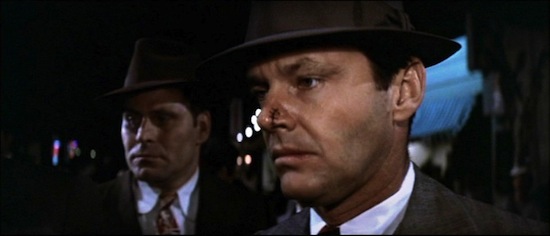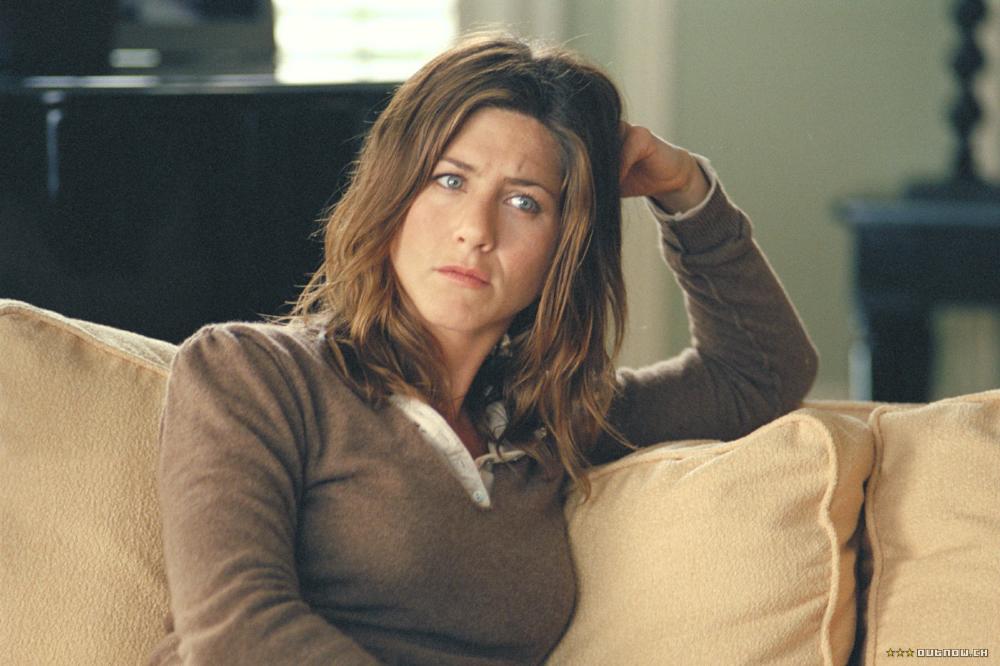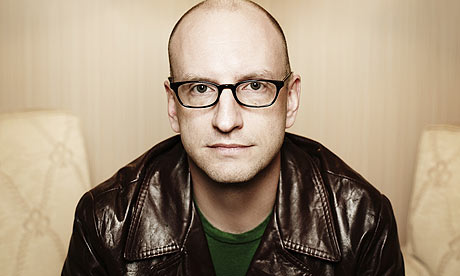As my friend and fellow movie reviewer A.J. Snyder
recently wrote, tuning into who directs and writes the movies you like most can be an easy way to track down more movies you will enjoy. As A.J. points out, while some movie stars -- George Clooney leaps to mind -- do a pretty effective job at consistently choosing high-quality projects, others -- Michael Caine, for instance -- are more liberal in said choices, and have starred in just as many terrible movies as decent ones. However, following a particular director or screenwriter allows you to engage with the work of someone who "[goes] to work to establish their vision within their medium," as A.J. writes, and if you choose well, the rewards can be great.
Of course, as A.J. also cautions us,
auteur theory -- the notion that the quality of a given cinematic work is largely determined by who directs it -- does not account for all great movies; far from it. Filmmaking is a collaborative and industrial art form, and there are a great many creative (directors, screenwriters, cinematographers, costume designers, actors) and non-creative (studio executives, MPAA Ratings Board workers) personnel who contribute significantly to the final product we see onscreen. Many of the best directors (and even some bad ones) tend to collaborate with the same creative team again and again, a move which speaks volumes about the importance of those other staffers' contributions. For example, many visually talented directors like Ridley Scott, J.J. Abrams, and even Zack Snyder often have their movies utterly ruined by shitty-ass screenwriters like
Damon Lindelof,
Roberto Orci, and
David S. Goyer.*
However, in many cases the director does have a fairly direct impact upon what makes it into the final cut. This can sometimes lead to excesses which may or may not represent artistic growth (I'm looking at you, Quentin Tarantino and Wes Anderson), but at the end of the day, I would rather see a "noble failure" by filmmakers with something interesting or unique to show me rather than something formulaic and cliched that simply "plays it safe."
So with that in mind, here are five directors working today who produce consistently good, even great work, whose filmographies are well worth checking out:
Nicole Holofcener
Writer/director Holofcener's latest film, the superb
Enough Said (2013), has been getting a great deal of
positive press lately (also
here and
here), perhaps largely due to the passing of one of its stars, James Gandolfini. While I really enjoyed Gandolfini's terrific performance in the film -- what a relief to see him doing something other than a stereotypically thick New Jersey mobster accent -- the real star of the show is Julia Louis-Dreyfus. She gives a nuanced, multi-layered portrayal that benefits from her impeccable comedic timing.
Yet the wonderfully engaging
Enough Said is no fluke; Holofcener is simply one of the best writer/directors working today. Her grasp of the subtleties of human emotions and her ability to mine comedy from the most unexpected aspects of interpersonal relationships is unparalleled by any other American filmmaker of whom I am aware. My personal favorite of her films (unless
Enough Said trumps it upon subsequent viewings) is 2001's
Lovely and Amazing, an ensemble piece about how several different women deal with issues of beauty, body image, parenting, and romance. Starring Holofcener mainstay Catherine Keener,
Lovely and Amazing is a must-see for anyone who enjoys offbeat slice-of-life type stories; Holofcener is a master of that form. I also strongly recommend Holofcener's recent efforts
Friends With Money (in which Jennifer Aniston plays a delightfully likeable slacker) and
Please Give (another solid ensemble piece).
Walking and Talking (1996), while a bit lower budget and rougher around the edges, is worth a watch for its excellent dialogue sequences and its inclusion of one of Liev Schreiber's finest onscreen performances (after Greg Mottola's
The Daytrippers of course -- Schreiber's best role).
Jennifer Aniston as underemployed slacker Olivia in Friends With Money.
Holofcener finally deserves our attention not just because she is so good at capturing the nuances of human interactions onscreen but also because she consistently treats subject matter almost never tackled by mainstream Hollywood cinema: the stories of women's lives, and (more recently) the lives of middle-aged, post-divorce men and women. And while she typically places more of the narrative focus upon female subjectivity, her male characters always shine as well -- see, for example, Jake Gyllenhaal and Dermot Mulroney in
Lovely and Amazing or Oliver Platt in
Please Give. That Holofcener renders these characters and their cinematic stories with such delightful humor, emotional sensitivity, and impeccable aesthetic craftsmanship (craftswomanship?) is what vaults her into the first rank of American film directors.
Director Steve McQueen with frequent collaborator Michael Fassbender.
Steve McQueen
McQueen's forthcoming picture,
12 Years a Slave, is already
wowing festival crowds and film critics, and promises to be one of the most talked-about films of 2013. However, even if a riveting drama about the realities of American slavery is not your cup of tea, you owe it to yourself to check out one or both of the UK director's previous two features.
Hunger (2008) is a beautifully shot, unflinchingly written account of the last days of Bobby Sands, the Provisional Irish Republican Army volunteer who went on a hunger strike in 1981 in order to protest the conditions in the British prison where he was being held as a political prisoner. Michael Fassbender -- surely one of the top four or five actors working in the world today -- delivers a riveting performance as Sands, and McQueen's camera and editing techniques raise this film from the realm of the simply harrowing to the artistically sublime. In particular, watch for the insanely long take during Sands' dialogue with the priest midway through the movie --
GoodFellas and
Children of Men, eat my shorts!
Michael Fassbender as Brandon in Shame.
However, for its subject matter alone, McQueen's second feature,
Shame (2011), is a true must-see film: depicting several days in the life of a present-day sex addict, again played by Fassbender,
Shame deals quite frankly and artfully with the issue of how contemporary internet sex culture impacts our ability to experience true intimacy. Essentially a drama about a dysfunctional family that omits most of the family melodrama,
Shame drives its potent and timely message home via an intense focus on Brandon, its male lead, and his sister Sissy, played with convincing
pathos by Carey Mulligan.
Shame is tightly written, inventively shot and edited, and brilliantly acted, and, while not for the sexually faint-hearted -- it surely earns its NC-17 rating -- it is on my short list of all-time best films.
Lars von Trier
Probably the world's most talented living filmmaker, the iconoclastic von Trier's work is admittedly not for everybody. His films, while visually breathtaking, tend to be somewhat grueling emotionally -- von Trier excels at rendering poetic the suffering and pain of his (usually female) protagonists. However, I think his most recent film,
Melancholia (2011), is accessible to almost anyone, and while a bit "slow" by Hollywood blockbuster standards, it at least features well-known stars (Kirsten Dunst, Keifer Sutherland) and a dramatic, apocalyptic science fiction plot that, art-film moments aside, should resonate with anyone who appreciates a well-made movie. I would also strongly recommend his earlier revisionist musical,
Dancer in the Dark (2000), in which Bjork delivers a surprisingly compelling performance and the song sequences alone, stunningly shot and choreographed, should take your breath away if you have any appreciation for the visual dimension of cinema. Once you have checked out a couple of these more palatable films and decided if von Trier's challenging but rewarding work is for you, you can make your way toward seeing his more relentlessly harrowing masterpieces like
Breaking the Waves (1996),
Dogville (2003), and his recent horror film,
Antichrist (2009).
Steven Soderbergh, probably the greatest living American film director.
Steven Soderbergh
I hereby predict that in fifty years, when future film critics and scholars look back at this period in U.S. film history, Soderbergh will stand out as the representative figure of late 20th century and early 21st century filmmaking. His substantial body of work is impressive for its volume (37 directorial credits since 1985), for its consistent quality, and for the wide-ranging breadth of its subject matter and aesthetic experimentation. Soderbergh is the undisputed master of the "one for them, one for me" style of independent filmmaking, in which he alternates between, on the one hand, big-budget studio-produced films like
Ocean's Eleven (2001),
Erin Brockovich (2000), and
Contagion (2011) and, on the other, low-budget, experimental passion projects like
The Limey (1999),
Bubble (2005),
Schizopolis (1996), and
The Girlfriend Experience (2009).
While John Cassavetes is surely the godfather of (the recent wave of) American independent cinema, and Jim Jarmusch's (somewhat Cassavetes-derivative)
Stranger than Paradise (1984) constitutes the opening salvo of the 1980s-'90s independent cinema boom, it was Soderbergh's
sex, lies, and videotape (1989) that made the American general public aware that independent cinema existed, arguably paving the way for the arrival of Quentin Tarantino a few years later. Shot on location in Louisiana on a budget of $1,200,000,
sex, lies was the first independently produced film to screen in wide release in the multiplex theaters, and its release and success showed indie distributor Miramax how to market independent fare "wide" to mainstream audiences.**
It is difficult to narrow down Soderbergh's vast body of high-quality films to just a few succinct recommendations, but here goes:
sex, lies, and videotape (1989) is an absolute must-see, a compellingly shot and acted ensemble piece about exactly what its title indicates. The fact that this film relaunched '80s icon James Spader's career should be incentive enough to check it out; but its intimate, character-driven narrative and intelligent editing style (including inventive use of sound bridges) would also set the tone for so many great Soderbergh films to come.
The Limey (1999) is an intense revenge thriller whose main stylistic innovation is an unusual use of editing and sound bridges that creates a very strange -- possibly physically impossible -- chronology. It is as if Soderbergh set out to out-Tarantino Tarantino here (in the non-chronological editing sense, not the wacky, offbeat dialogue sense), pushing the whole "let's fuck with the chronology of this story" trick that QT uses in
Pulp Fiction onto a wholly different (and much more subtle) level. The beauty of what Soderbergh achieves in
The Limey is that his editing tricks could easily go unnoticed by the average viewer unless s/he tunes in carefully and/or has been forewarned that they exist. No showoff, Soderbergh prefers to execute this particular cinematic experiment in a way that does not call undue attention to itself or interfere with the viewer's ability to simply sit back and enjoy
The Limey as a badass revenge thriller starring Terence Stamp. In other words, this is a great film for cinephiles and casual filmgoers alike.
Bubble (2005) is probably my personal favorite Soderbergh film, but it isn't for everyone; it is essentially Soderbergh "doing the Jarmusch thing," i.e., shooting most of the film in long takes in an extremely low-budget style with a cast of non-professional actors. If you like offbeat, low-budget indie fare that is understated yet packs a serious dramatic wallop, don't miss
Bubble.
Contagion (2011) is simply one of the best disaster movies I have ever seen, and I have seen a great many, being a big fan of the genre. The film is a smartly intertwined multi-strand tale of a global disease outbreak, shot in Soderbergh's preferred "personal" style, i.e., more focused upon individuals and their varied responses to the catastrophe rather than grandiose set pieces and a cast of thousands. In this case, the intimacy of the cinematography and screenwriting contribute to the film's overall intensity, and the whole thing ties together quite brilliantly by the closing shot. I recommend
Contagion to anyone, it's simply a great film by any scale of evaluation.
UPDATE 1/17/2016: This nice
IndieWire piece affirms my claim that Soderbergh is the most important and artistically daring filmmaker of his generation.
Nicolas Winding Refn
This is a tough one because I put Refn on this list knowing his work will not be for everyone. Sure, three-fifths of this list, with the exception of Soderbergh and Holofcener, consists of "art film" directors, so few of these filmmakers are likely to appeal to you if you require your movies to stick to cause-and-effect-driven plots, adhere to "action beats," and conclude with comfortingly pat resolutions.*** However, even more so than von Trier, Refn is out to challenge the mainstream filmgoer, because his sustained cinematic project seems to be to artfully revise and reinterpret certain Hollywood film genres. Sure, this is broadly true of von Trier (
Antichrist is a horror film,
Dancer in the Dark a musical, and most of his early films are female-centered melodramas) and even Soderbergh (who revises the revenge film in
The Limey and the disaster film in
Contagion), yet Refn revises the genres in which he works even more radically than these other two.
The great Mads Mikkelsen as One-Eye in Refn's Valhalla Rising.
Refn is an emphatically
visual director, and many of his films --
Valhalla Rising (2009),
Drive (2011), and
Only God Forgives (2013) -- unfold with very little dialogue. He also favors stunning
mise-en-scene, liberal use of slow-motion, and long takes. Therefore, folks approaching Refn's work expecting standard genre fare will likely be thrown off by his bold, "artsy" aesthetic strategies. But that is the whole fun of appreciating Refn, to see how he takes a basic generic structure like the heroic fantasy film (
Valhalla) or the martial-arts revenge film (
Forgives) and turns it inside-out with his long takes, verbally reticent characters, and insanely artistic production designs. In short: you have to see these films to believe them. And for me, that is the hallmark of a truly great filmmaker.
To conclude, I bestow
Honorable Mention upon directors Michael Haneke, David Fincher, Bong Joon-ho, Jake Kasdan, Harmony Korine, and, lest ye think I overlook action film directors, Michael Mann and Kathryn Bigelow. I will save discussion of these other meritorious filmmakers for a future post.
--
* I also think Peter Jackson was somewhat ill-served by his
Lord of the Rings trilogy screenwriters, Fran Walsh and Philippa Boyens, but that is a more complicated case that I shall return to in a later post.
** This knowledge would pay off even more dramatically when Miramax mounted their extremely expensive, innovatively aggressive, and highly successful Oscar campaigns for
Shakespeare in Love (Best Picture) in 1998 and for Hilary Swank (Best Actress) in 1999 -- see Peter Biskind's
Down and Dirty Pictures for more on this interesting subject.
*** The definitive essay that outlines the parameters of art cinema is
David Bordwell's "
The Art Cinema as a Mode of Film Practice."













